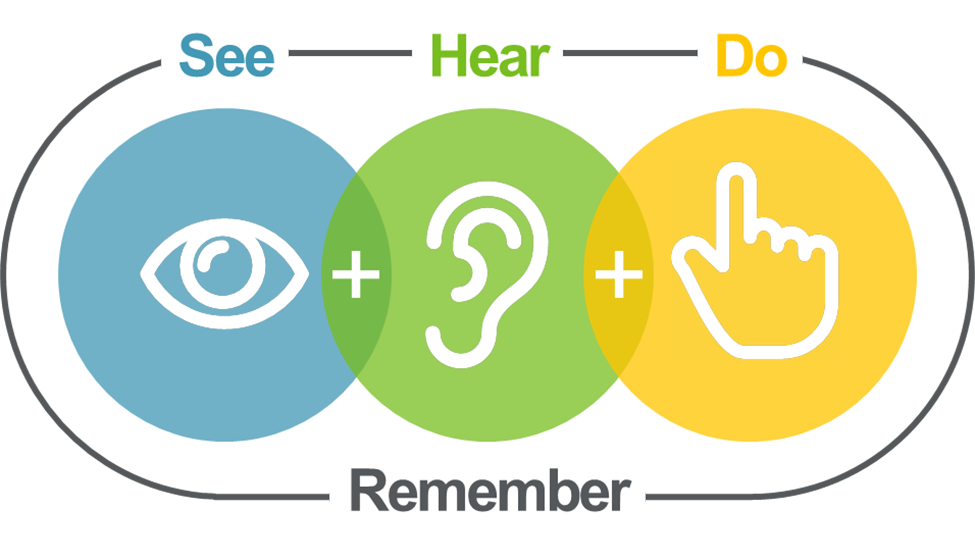
Designing for How We Learn: One Simple Mantra
The basis of learning has always been the opportunity to transfer knowledge. However, now we know a lot more about the different ways this transfer of knowledge can happen. People can learn anytime, anywhere and at any age with multiple devices. So, if a university is spending hard-won capital dollars on new academic facilities, both the teaching methods and the teaching environment have to provide students with experiences that they cannot obtain on their own.
The mantra "See + Hear + Do = Remember" drives the design of a classroom environment. There are very real configuration issues for classrooms and instructional laboratories that are often missed in the architectural divide of form from function. Sightlines and acoustics are critical for successful learning, and there are some simple rules of the road.

See
Every student in the room must be able to see the material being presented. We have rich technology available; there is a “magic” sightline of 90° to a focal point (e.g., screen), an acceptable sightline of 130°, and beyond that, sightlines are severely diminished and compromise learning. If there are seats in a learning environment that are not usable due to insufficient sightlines, this is valuable square footage that is wasted over the entire life of the facility. In addition, the material that is presented needs to be in text large enough to be able to read. One professional organization advises that no text under 16 point should ever be used on a screen.
Students not only want to see the instructor. If they are truly participating in active learning activities, they need to see each other too. This means crafting the seating in a way conducive to seeing and working with each other instead of rows of seats facing forward. Tables that are bowed out slightly in the middle, round tables and horseshoe-shaped rows in large rooms are all ways to provide greater ability for people to see each other.
Hear
Sightlines are not the only consideration for a good classroom configuration, however.
One of the best resources for understanding the importance of acoustics is a TED talk by Julian Treasure, an acoustics engineer, called Why Architects Need to Design with their Ears. In his talk, he discusses how, in a traditionally designed classroom with standard acoustical practices and hard surface finishes, students who sit from the fourth row back can miss one of two words being said; that’s 50% of the material being covered lost due to poor speech intelligibility, nothing to do with the clarity of the speaker.
This cacophony is due partly to the number of conversations and the reverberation time in the room.
Smart acoustical design and awareness of reverberation time are critical for classrooms and teaching laboratories, where understanding the oral material is crucial to the learner. Simultaneously, the learners themselves often have issues. According to Treasure, several factors can affect students’ ability to hear:
- Up to one in eight learners have impaired hearing at any one time, due to colds, allergies, etc.
- Students with English as their second language may need extra time to process what they hear.
- Introverts, who make up as many as 33% of learners, find it more challenging than extroverts to process large amounts of stimuli at once.
Thus, many students have enough to contend with without the learning environment compounding the problem. Several technical factors within the classroom can aid or hinder students’ ability to hear. The most basic factor is reverberation time or the amount of time it takes for sound to decay 60 decibels from its initial level. When the reverberation time is too long, the instructor talks while her words from a few seconds ago still echo around the room. Thus, students are fighting to hear clearly. The new LEED v4.0 for Schools recommends a reverb time of 0.4 seconds, yet reverb time is over 1 second in many classrooms.
Installing acoustic ceiling tiles in a room with otherwise hard surfaces is insufficient to provide appropriate acoustics. Carpet and other sound-absorbing materials, adding acoustic treatments on walls coordinated with screens and whiteboards and attenuating noisy HVAC systems and other outside noise sources are all tools to enhance the acoustic properties of a learning environment.
Do & Remember
We know that students retain information best when actively participating in learning and applying a concept. This is where active learning classrooms play an important role.
In College is Dead. Long Live College! Amanda Ripley states:
“Studies of college students have shown that they can focus for only 10 to 18 minutes before their minds begin to drift; that’s when their brains need to do something with new information — make a connection or use it to solve a problem” (Ripley, p. 39.).
With knowledge of that 10-18-minute window, instructors can structure the class to engage students in more impactful ways. That is the essence of active learning.
The following article in this series will focus on ways to implement ideas to make classrooms and instructional labs more conducive to learning.
Citations:
- Ripley, A. (2012). College is dead. Long live college. Time Magazine, 180(18), 33-41.
Read more from Kim's Designing For How We Learn Series.
- How We Got Here
Our education team is constantly studying how we learn and how that informs how we think about designing space. - Lecture Halls
Applying the "See + Hear + Do = Remember" framework to lecture halls requires some exploration into how they will be used. - Classrooms
Active learning is prolific in today's classroom environments. We explore how to ensure our learning environments support it using the "See + Hear + Do = Remember" framework. - Maker Spaces and Instructional Laboratories
Maker spaces and instructional laboratories inherently support active learning. We explore the variety of maker spaces and teaching labs and how we can design the most useful and creative spaces.

